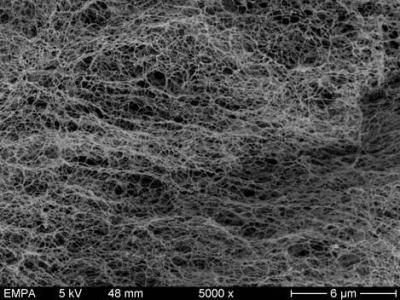Scientists at Empa have designed a production method for nanocellulose powder, a raw material used in the production of polymer composites that can be utilized as a filter and membrane material in biomedicinal applications and in lightweight structures for the automobile market.
 A scanning electron microscope image of chemically modified, nanofibrillized cellulose.
A scanning electron microscope image of chemically modified, nanofibrillized cellulose.
The cellulose researchers at the Wood Laboratory of Empa have processed wood pulp to isolate cellulose nanofibers, which are strongly interlinked and have a length of several micrometers and a thickness of few nanometers. The surface area of the material is extremely large, where physical-chemical reactions of materials such as polymer compounds, water, inorganic and organic chemicals can take place. Thus, the highly reactive biodegradable raw material finds use in far-reaching technical applications.
The isolated nanocellulose from the wood pulp is originally in the form of an aquatic suspension. During the drying process, the cellulose nanofibers join together producing rough clusters, resulting in the loss of the material’s superior mechanical properties. The method developed by the Empa scientists enables the material to be dried out without forming clumps or becoming rough.
The researchers treated the cellulose utilizing a completely harmless technique that can be executed easily on a large scale and is ideal even for applications in the food industry. When re-dissolved in water, the dried nanocellulose powder produced by the method demonstrates the same superior properties of unmodified, undried cellulose.
This new method allows the production of a better replacement to traditional cellulose suspensions used in the manufacturing of bio-nanocomposite materials. The suspensions currently being utilized comprise more than 90% of water, which results in high logistics expenditures and raises the risk of degradation by fungi or bacteria. The Empa researchers used the innovative nanocellulose powder to strengthen hydrogels, adhesives and biodegradable synthetics.